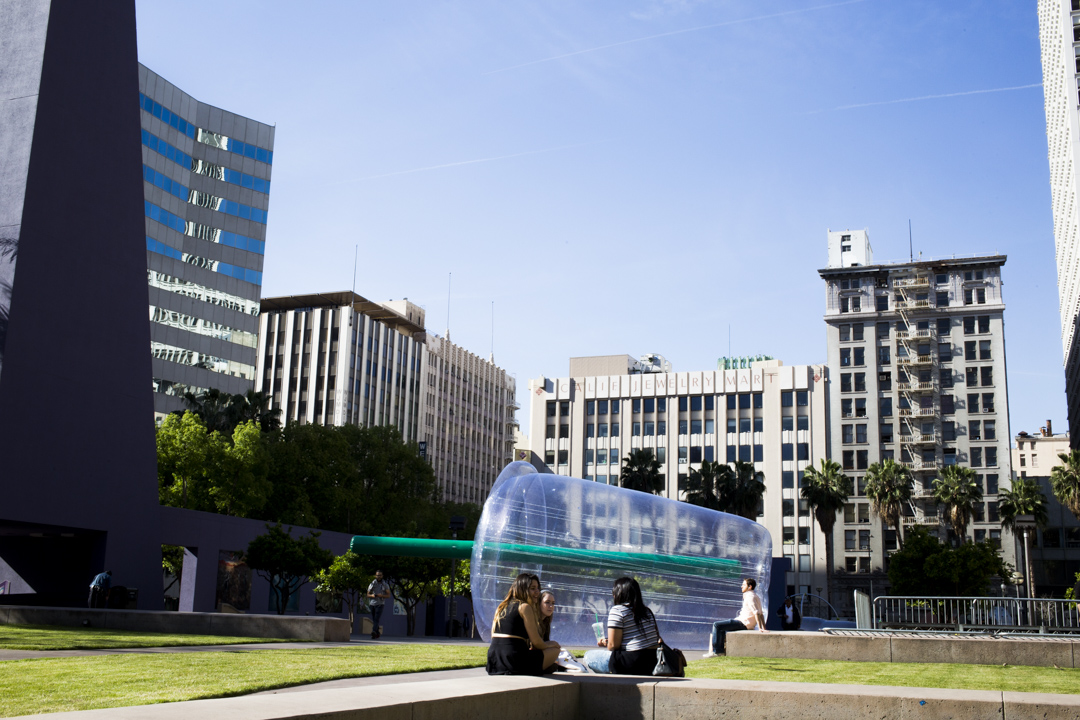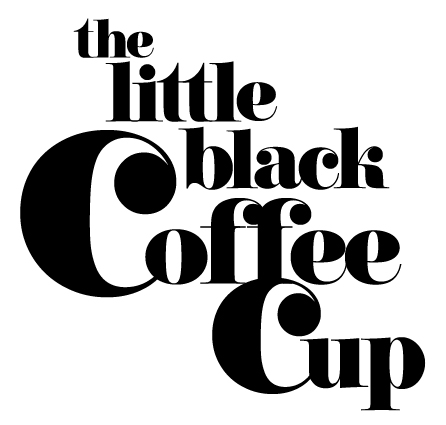This Art Installation Will Make You Rethink Your Plastic Coffee Cup

Natural Plasticity by Jana Cruder & Matthew LaPenta
Have you ever thought about your plastic coffee cup? Have you considered what happens to that cup after you use it? Have you ever taken a moment to contemplate the environmental implications of all the plastic take-away cups or water bottles you've ever used? Two Los Angeles based artists, Jana Cruder and Matthew LaPenta, are on a mission to bring consciousness to our relationship with disposable plastics through their traveling installation titled Natural Plasticity.
Cruder and LaPenta constructed two giant inflatable sculptures—one a disposable coffee cup, the other a water bottle— to create awareness by "ruining views." To date, their installation has popped up in Pershing Square, Griffith Park, and tomorrow (May 7th) their piece will make an appearance on Venice Beach.
Jana kindly took some time out to answer a few questions about Natural Plasticity and I am thrilled to share her thoughtful responses...
Photo: Jana Cruder
tLBCC: What compelled you to create a work that addresses the issue of disposable plastic?
Jana Cruder: After seeing the film Plastic Planet—once you see plastic everywhere you can’t un-see it. I noticed plastic in my every day and also while traveling around the globe. I was seeing it everywhere: from countries who don’t have recycling in place to my own city, L.A. I noticed it piling up in gutters, on sidewalks, on the entrances to freeways.
I found myself asking why no one else saw plastic the way I did—EVERYWHERE and urgently needing to be addressed. It was obvious to me that people disposed of plastic the same way they consumed it—completely un-aware of their behavior and carelessness.
Matthew and I were hiking in one of our National Parks and we were on a pretty deep hike when I noticed two plastic water bottles on the side of the trail—just placed there. I was infuriated! I wanted to make these things so big people couldn’t ignore them. I wanted to create the opportunity for someone to come upon these in nature and look at the bottle or cup in their hand and then look at this giant 'plastic middle finger' and go "hmmmm.." I wanted to create a moment where people would be forced to stop, think and see their impact. That moment of awareness is the point we can start to shift the conversation and relationship to disposable plastic.
tLBCC: To fully understand the scale of your sculptures, how big are they? What are they made of? And, how long do they take to install?
Jana Cruder: When we first had the idea we thought we’d make the sculptures out of glass. After those estimations came in, they would be too heavy and cumbersome for a moving install. So we decided to fight fire with fire and the pieces are made of post consumer plastic. The cup is 35ft long x 9ft high while the bottle is 20ft long and 7ft high. They take about 2.5 hours on inflation and 2 hours on deflation.
Photo by Jana Cruder
tLBCC: You titled your pair of inflatable sculptures “Natural Plasticity.” What does the title of the piece mean to you?
Jana Cruder: Natural Plasticity was derived from looking at the meaning of plasticity and then thinking of that in terms of our natural environment. Plasticity is the adaptability of an organism to changes in its environment or differences between its various habitats, existing in or caused by unnatural additives: The changing of our natural environment due to the impact of disposable plastic.
Our natural world is losing its plasticity or it's ability to change and bounce back from un-natural additives such as disposable plastic. Looking at the ocean and its ratio of plastic to plankton. Looking back at the impact of the choice of disposable plastic. This installation brings the impact of consumer and corporate behavior regarding disposables into clear sight. Beckoning the viewer to evaluate their own behavior with plastic consumption. To change what is manufactured and marketed we must first change the consumer.
Photo by Jana Cruder
tLBCC: In general what has the response been to your work and the message behind it? Do you feel as though the public is open to facing the challenges created by our disposable plastic use?
Jana Cruder: Reactions have been all over the board. Seriously, some people get angry that we’re putting it in their face. Their first response is "oh, I recycle," as they are holding a disposable Starbucks cup. To that we say, well, its not really about recycling anymore. The fact is, we produce so much that we can’t keep up with the recycling. It is about being responsible and not using disposables.
People are often amazed to find out that they themselves produce—on average a year—enough plastic waste to fill the largest of our pieces. Sometimes people are cool with the conversation, other people feel guilty and others get angry. Most people love it though. Those that get it think its smart and very poignant and—bravo! They love interacting with it, and watching it sway slightly in the breeze like real discarded trash.
tLBCC: On your website it was mentioned that Natural Plasticity involves “looking back at the impact of the choice of disposable plastic.” Our current coffee culture is very reliant on the convenience of the take-away cup—so much so that choosing a single-use cup is not really a conscious decision for most of us—it’s more of a habit or conditioned behavior. To that end, hearing the word choice in your statement is empowering. So, how can we as consumers make better or more conscious choices in our day to day lives? How have you navigated changing your own habits in relationship to single-use plastics?
Jana Cruder: I love this question, it really gave me chills. After becoming aware of this problem, I started to observe myself first and then began to change my behaviors. It seriously took me almost two years to change my own relationship with plastic—everything comes in plastic from the food we buy to the pens we use. I had to re-evaluate everything I purchase. The best thing is eradicating plastic from my grocery shopping cart—my cart looks like the garden of eden, full of fresh un-packaged produce. We are a drastically plastic reduced household and still have a way to go but we go out of our way not to consume plastic. Trust me it is not convenient to live that way. But it is a choice. The choice is up to us.
Our culture globally is shaped by consumption. We decided to support a shift in consumption awareness and behaviors. After researching, and observing myself and others at length around the use of single-use plastics I believe that if we the consumer say NO, that they the producer will come up with an alternate if they want us to keep buying their product. NO I don’t want to put my hot beverage into a cup that will release toxins into my food, and NO I refuse to use something that I can not re-use. Also, may I plug that corn-based compostable’s are not the answer as well—they are leveling rain forests to grow GMO corn.
So we need to be aware and simply be allowed to bring our own containers. We have to make the choice to become a responsible species. So by putting this concept in the face of the public we aim to raise the consciousness around the epidemic of plastic choking our eco-system.
Photo by Jana Cruder
tLBCC: I can’t help but notice your intention to create a sculpture of a disposable coffee cup with a green straw. Obviously recreating this cultural icon brings attention to a very specific brand. Can you tell us a little bit about your choice to reference the Starbucks cup? Do you think creating brand identities through disposables is going to become a faux pas in the future?
Jana Cruder: We chose to pay homage to the icon of the green straw, and we all know who that has a likeness to. I really noticed that in 1995 the customizable personal beverage emerged from nowhere and culturally gave people a sense of voice, individuality and created life long habits... BANG! 20 years later we’re looking billions and trillions of cups that are used for maybe 10 minutes. What bugs me is that most people don’t even know they can ask for a for-here cup. They stay in the store with this cup and toss it before they leave. Its a habit—a un-consciousness habit. We want corporations to take responsibility in re-educating their employees and their customers and work to give clearer better options. Call us Utopians but we hope that in the future, if you waste, or your company wastes, and exploits others or the environment that will be a faux pas!
tLBCC: Natural Plasticity is a moving exhibit. Your sculptures have been in Pershing Square, Griffith Park, and will pop-up tomorrow (May 7th 2016) at Venice Beach. Where are your pieces headed next?
Well that is up to the powers and energies that support this project. We are seeking a fellowship, grant, endowment or donations to support us to continue the installations and awareness. It takes a tremendous amount of effort to put theses installs on and we typically need permits in the cities we install. So far we have self-funded the fabrications and thus we have a donation button on our site and we are really hoping some of the non-profit environmental groups that have approached us will get some funding for our project to travel. We’re aiming to take this through the National Parks late summer early fall and from there possibly east coast or internationally. A lot of people are responding we’re just waiting to see what aligns financially the soonest.
tLBCC: Is there anything else we should know about Natural Plasticity and the message you are sharing?
We may be ahead of our time, but I sense we’re on to something. We as a species would be silly to ignore this opportunity to evolve and live in better harmony and balance with our planet.
Please follow us individually and if interested in connecting please reach out.
Cruder / La Penta: website
Instagram: @janacruder @matthewlapenta
Help fund Natural Plasticity: donate





